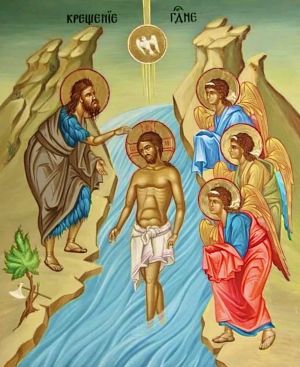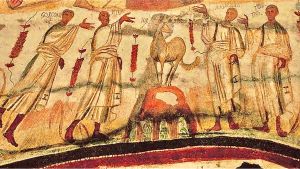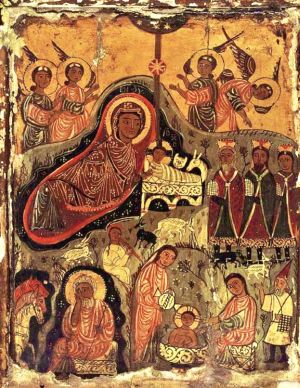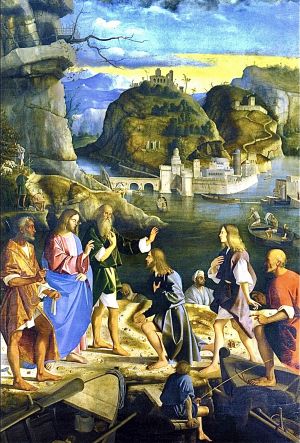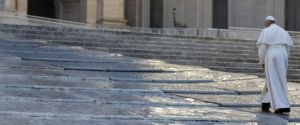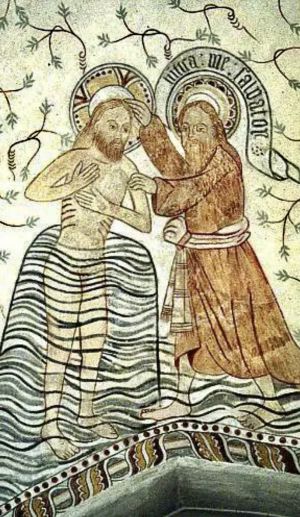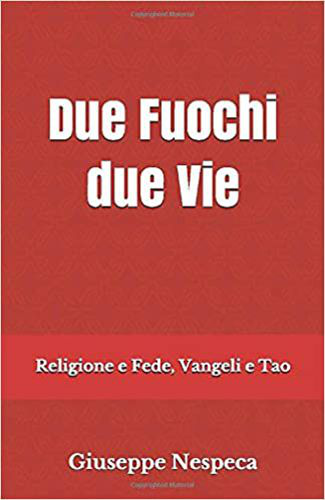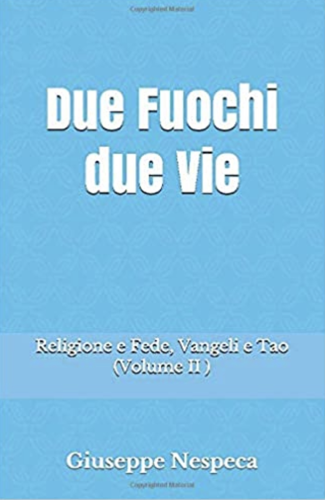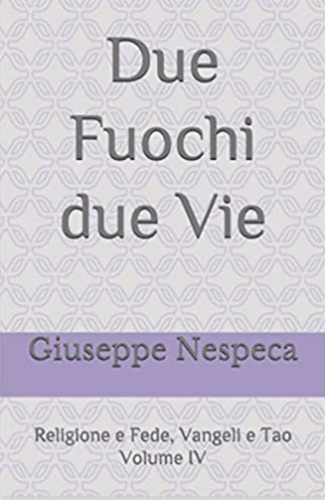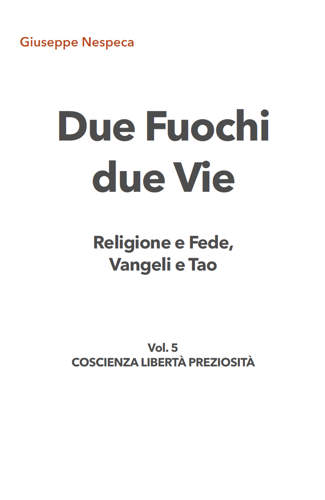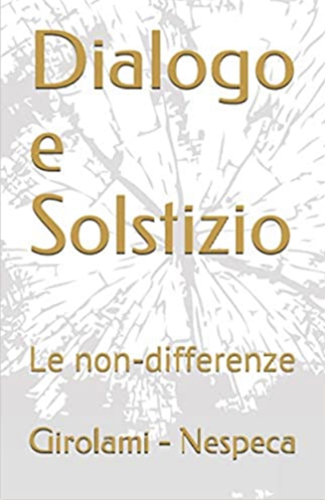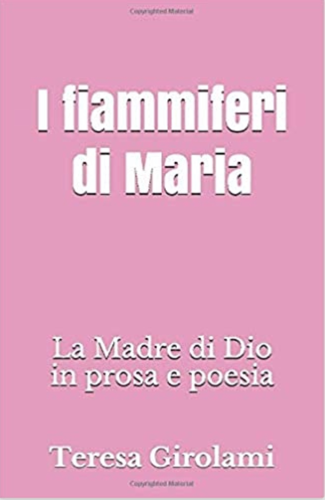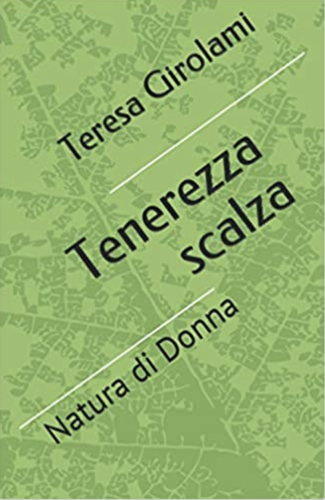
don Giuseppe Nespeca
Giuseppe Nespeca è architetto e sacerdote. Cultore della Sacra scrittura è autore della raccolta "Due Fuochi due Vie - Religione e Fede, Vangeli e Tao"; coautore del libro "Dialogo e Solstizio".
Baptism of the Lord
Baptism of the Lord (year A) [11 January 2026]
May God bless us and may the Virgin protect us! Today marks the end of the Christmas season, as we give thanks to Providence for having been able to celebrate this Mystery of Light and Peace in an atmosphere of serenity.
*First Reading from the Book of the Prophet Isaiah (42:1-4, 6-7)
The Servant of the Lord and his universal mission. This text from Isaiah is rich and complex, but it can be divided into two main parts. In both parts, it is God who speaks, but in two different ways: in the first part, he speaks of his Servant, and in the second, he addresses him directly. First part: God describes the Servant as the bearer of justice and universal law: 'He will bring justice to the nations... he will not fail or be discouraged until he has established justice on earth; he will not falter until he has established it on earth'. 'I have called you for justice': here judgement does not mean condemnation, but salvation and liberation. The Servant will act with gentleness and respect for the fragile, he will not crush the weak or extinguish those at risk. His mission concerns all humanity, because God desires that even the distant islands aspire to his justice, to his salvation. In all this, the Servant is sustained by the Spirit of God: 'Behold my Servant, whom I uphold... I have placed my Spirit upon him'. Part Two: God clarifies the Servant's mission: "to open the eyes of the blind and bring prisoners out of the dungeon... those who dwell in darkness." Here, judgement becomes total liberation, a passage from darkness to light. The mission is universal: the Servant is the light of the nations, and God continues to sustain him: "I, the Lord, have called you... and taken you by the hand." Who is this Servant? Isaiah does not specify, because it was clear to his contemporaries: the Servant is the people of Israel, called to be the privileged instrument of salvation. Messianism in Isaiah is not individual but collective: the small faithful nucleus becomes light and guidance for the whole world. Jesus, at his baptism in the Jordan, takes the lead of this servant-people and fulfils the mission announced by the prophets. The key message is this: God's judgement is not condemnation but liberation and universal salvation. God supports the Servant and entrusts him with the task of bringing light and justice to all nations. God's faithfulness and creative power are the guarantee of our hope, even in the most difficult moments.
*Important elements: +Text divided into two parts: God speaks about the Servant and directly to the Servant. +Judgement of the Servant = salvation and liberation, not condemnation and universal mission: light for the nations, opening the eyes of the blind, liberation of prisoners. +Gentleness and care for the fragile: 'he will not extinguish a dimly burning wick'. +Support of the Spirit of God on the Servant understood as the people of Israel, collective messianism. +Jesus at his baptism takes on the leadership of the servant-people. +Hope based on God's faithfulness and creative power.
*Responsorial Psalm (28/29)
To understand this psalm, one must imagine the force of a violent storm, shaking the country from Lebanon and Hermon to the desert of Qadesh. The psalm describes the voice of the Lord as powerful, thunderous, lightning-like, capable of breaking cedars and frightening the desert. This voice recalls the revelation at Sinai, when God made his voice heard to Moses amid fire and lightning, and every word of the Law appeared as flashes of fire. The name of God (YHWH, the Lord) is repeated several times, emphasising God's living presence and his saving action. The repetition of 'voice of the Lord' recalls the creative Word, as in the first chapter of the book of Genesis: the Word of God is effective, while idols are powerless. The psalm insists on God's sovereignty: God is the only legitimate king, worthy of glory and worship, and soon everyone – people and false powers – will recognise his dominion. God's powerful voice also evokes victory over the waters and chaos, as in the time of the flood or the liberation from Egypt, demonstrating his saving and liberating power. The central theme is the glory of God, repeated several times, and the anticipation of a time when all humanity will recognise his kingship. The psalm is linked to the feast of the Baptism of Christ, when the Kingdom of Heaven draws near through Jesus: God is finally recognised as king and his salvation is announced to all.
*Important elements: +Powerful image of the storm: voice of the Lord, lightning, broken cedars and Reference to Sinai: Word of God as fire, Law and covenant. +Repetition of God's name: YHWH, sign of presence and power. +Creative Word: as in Genesis, the Word is effective, idols are powerless. +Universal sovereignty of God: the only legitimate king, worthy of glory. +Victory over the waters and chaos: flood, exodus from Egypt. +Glory of God: central theme, anticipation of his universal recognition. +Connection to the baptism of Christ: manifestation of the Kingdom of Heaven and universal salvation
*Second Reading from the Acts of the Apostles (10:34-38)
In this account from Acts 10, we witness a truly revolutionary moment: Peter, guided by the Holy Spirit, breaks all the social and religious rules of his time and crosses the threshold of the house of a pagan, the Roman centurion Cornelius. Cornelius is a pious man who fears God, esteemed by the Jews for his almsgiving and justice, but he is not circumcised. He receives a vision: an angel invites him to send for Peter in Joppa, where he is staying with Simon the tanner. At the same time, Peter receives a vision from heaven: a large sheet filled with animals orders him to eat, but he refuses because, according to the Law, they are unclean. A voice answers him: What God has declared clean, you must not declare unclean. This prepares him to understand that no man is unclean in God's eyes and that faith is no longer limited by nationality or ritual laws. When Cornelius's messengers arrive, the Holy Spirit confirms to Peter: Follow them without hesitation, for it is I who send them. Peter goes down, welcomes them, and sets out for Caesarea with some Christians, aware of the importance of the meeting. The arrival at Cornelius' house is significant: Peter explains to everyone that God is impartial and welcomes anyone who fears him and does good, regardless of nationality. The Holy Spirit falls on all those present, even on the pagans, showing that the gift of the Spirit is no longer reserved for Jews alone. Peter concludes that these pagans must also be baptised, because they have received the Holy Spirit just like the Jewish believers. This episode fulfils what Jesus had promised: the apostles would be witnesses to the ends of the earth (Acts 1:8). The election of Israel is not denied, but salvation in Christ is now open to all nations.
*Important elements: +Missionary revolution: Peter crosses the threshold of a pagan's house by the will of the Holy Spirit. Cornelius, a devout pagan who fears God, is an example of spiritual openness. +Peter's vision: nothing is unclean to God, universal openness of faith, and the Holy Spirit guides Peter, confirming the call of the pagans. +Reception and baptism: even pagans receive the Spirit and the sacrament of water. +Universality of the Gospel: fulfilment of the mission to the ends of the earth. +Balance: election of Israel confirmed, but salvation accessible to all.
*From the Gospel according to Matthew (3:13-17)
The baptism of Jesus marks his first public appearance: until then, for many, he was just Jesus of Nazareth. Matthew presents him simply as Jesus, who comes from Galilee and goes to John to be baptised in the Jordan. This gesture becomes the first revelation of his true role as Messiah in the eyes of all. The main images in this text are: The march to the Jordan: Jesus travels through Galilee to the banks of the river, as do the other Jews who go to John for the baptism of conversion. The gesture of John the Baptist: initially surprised and hesitant, John recognises in Jesus the one who is greater than himself and who will baptise in the Holy Spirit and fire. The heavens opening and the dove: the open heavens symbolise the fulfilment of Israel's expectations; the dove represents the Holy Spirit descending on Jesus, recalling the divine presence over Creation and the promised Messiah. The main words are: John expresses his amazement: ' I need to be baptised by you!' recognising the greatness of Jesus. Jesus replies: Let it be so now, for thus it is fitting for us to fulfil all righteousness, that is, to conform fully to God's plan. This shows Jesus' humility and his complete solidarity with humanity. The voice of the Father from heaven: 'This is my beloved Son, in whom I am well pleased' . With this phrase, Jesus is recognised as Messiah-King and Messiah-Servant, fulfilling the prophecies of Isaiah and the Davidic promise: God declares his love and his saving mission upon him. And these are the theological and spiritual meanings: Jesus fully enters into the human condition, even though he is without sin, taking the place of sinners. Baptism represents a new creation: the waters of the Jordan symbolise purification and the journey towards the spiritual Promised Land, guided by the Spirit. The scene reveals the Trinity: the Father speaks, the Son is baptised, the Spirit descends like a dove. Baptism is the beginning of the building of the Body of Christ: all those who participate in baptism are integrated into this saving mission.
St. Gregory of Nazianzus writes: "Christ is baptised not to be purified, but to purify the waters" (Oratio 39, In Sancta Lumina).
*Important elements: +First public manifestation of Jesus: revelation of the Messiah. +Solidarity with humanity: Jesus places himself among sinners to fulfil God's justice. +Role of John the Baptist: recognises the Messiah and his baptism in the Spirit and fire. +Presence of the Holy Spirit: symbol of the dove, confirms the mission and the new creation and Voice of the Father: confirms the divine sonship and love for Jesus. +Messiah-King and Messiah-Servant: fulfilment of Isaiah's prophecies and the Davidic promise. +New creation and journey towards the spiritual Promised Land: baptism as entry into the Body of Christ. +Revelation of the Trinity: Father, Son and Holy Spirit present in Baptism. +Universality of the message: Baptism opens the way to salvation for all humanity.
+ Giovanni D'Ercole
Behold the Lamb: Tenderness without neurosis. Selfishness without downgrades
Epiphany of the Lord
Epiphany of the Lord (year A) [6 January 2026]
May God bless us and may the Virgin protect us! Happy Epiphany!
*First Reading from the Book of the Prophet Isaiah (60:1-6)
In these dark days, here is an announcement of light! This text from Isaiah is filled with insistent images of light: "Arise, shine, for your light has come, and the glory of the Lord has risen upon you... The Lord shines upon you... His glory appears upon you... Then you will see and be radiant." It is precisely this abundance of light that makes us understand that the real climate is anything but bright. The prophets do not cultivate paradox, but the art of hope: they speak of light because the people are immersed in the darkest night. The historical context is that of the post-exile period (525-520 BC). The return from Babylon did not bring the expected prosperity. Tensions are high: between those who remained in the country and those returning from exile; between different generations; between Jews and foreign populations settled in Jerusalem during the occupation. The most painful issue concerns the reconstruction of the Temple: the returnees refuse the help of groups considered religiously unfaithful; this gives rise to a conflict that blocks the work and dampens enthusiasm. As the years passed, discouragement set in. It was here that Isaiah, together with the prophet Haggai (cf. 1:2-8, 12-15; 2:3-9), provoked a spiritual awakening. Sadness is not worthy of the people of the promises. The prophet's one great argument is this: Jerusalem is the city chosen by God, the place where He has placed His Name. For this reason, Isaiah can dare to say: 'Arise, Jerusalem! Shine forth'. Even when everything seems dark, God's faithfulness remains the foundation of hope. The almost triumphal language does not describe a situation that has already been resolved, but anticipates the day that is coming. In the night, we look for the dawn: the prophet's task is to restore courage, to remember the promise. The message is clear: do not be discouraged; get to work, rebuild the Temple, because the light of the Lord will come. Three final points: Faith combines lucidity and hope: seeing reality does not extinguish trust. The promise is not a political triumph, but God's victory, his glory that illuminates humanity. Jerusalem already points to the people and, beyond the people, to all humanity called to communion: God's plan transcends every city and every border.
*Important elements: +Post-exilic context (525-520 BC) and climate of discouragement. +Internal conflicts and blockage of the reconstruction of the Temple. +Language of light as an announcement of hope in the night. +Vocation of Jerusalem: chosen city, place of Presence. +Prophetic call to action: rise up and rebuild. +Hope based on God's faithfulness, not on political successes. +Universal openness: the promise concerns all humanity
*Responsorial Psalm (71/72)
Men dream and God carries out his plan. Psalm 71 ideally brings us into the celebration of a king's coronation. The accompanying prayers express the deepest desires of the people: justice, peace, prosperity for all, to the ends of the earth. It is the great dream of humanity throughout the ages. Israel, however, has a unique certainty: this dream coincides with God's own plan. The last verse of the psalm, which blesses only the Lord and not the king, offers us the key to understanding. The psalm was composed after the exile, at a time when there was no longer a king in Israel. This means that the prayer is not addressed to an earthly sovereign, but to the king promised by God, the Messiah. And since it is a divine promise, it is certain. The whole Bible is permeated with this unshakeable hope: history has meaning and direction. The prophets call it 'the Day of the Lord', Matthew 'the Kingdom of Heaven', Paul 'the merciful plan'. It is always the same plan of love that God tirelessly proposes to humanity. The Messiah will be its fulfilment, and it is He whom Israel invokes in praying the psalms. This Psalm describes the ideal king, awaited for centuries, in continuity with the promise made to David through the prophet Nathan: a kingdom stable forever, a king called the son of God. Over the centuries, this promise has been deepened: if the king is the son of God, then his kingdom will be founded on justice and peace. Each new coronation rekindled this expectation. Yet the ideal kingdom has not yet been fully realised. It may seem like a utopia. But for the believer it is not: it is a promise from God, and therefore a certainty. Faith is the anchor of the soul: in the face of the failures of history, the believer does not give up hope, but waits patiently, certain of God's faithfulness. The psalm announces a decisive reversal: power and justice will finally coincide. In God, power is only love. For this reason, the messianic king will free the poor, defend the weak and bring endless peace. His kingdom will have no boundaries: it will extend to the whole earth and last forever. For Israel, this psalm remains a prayer of expectation for the Messiah. For Christians, it is fulfilled in Jesus Christ, and the episode of the Wise Men is already a sign of the universality of his kingdom: the nations come to him, bringing gifts and adoration.
*Important elements: +Psalm 71 as a prayer for the universal desires for justice and peace. +Coincidence between man's dream and God's plan. +Post-exilic composition: waiting for the king-Messiah. +Promise made to David (2 Sam 7) as the foundation of expectation. +History has meaning and direction in God's plan. +The ideal king: justice, peace, defence of the poor. +God's power as love and service. +Universal and endless kingdom. +Messianic Jewish reading and Christian fulfilment in Jesus Christ. + The Wise Men as the first sign of the fulfilment of the universal promise
*Second Reading from St Paul's Letter to the Ephesians (3:2...6)
This passage is taken from the Letter to the Ephesians (chapter 3) and takes up a central theme already announced in chapter 1: the 'merciful plan/mystery of God'. Paul recalls that God has made known the mystery of his will: to bring history to its fulfilment, recapitulating in Christ all that is in heaven and on earth (Eph 1:9-10). For St Paul, the mystery is not a closely guarded secret, but God's intimacy offered to man. It is a plan that God reveals progressively, with patient pedagogy, just as a parent accompanies a child in the discovery of life. Thus God has guided his people throughout history, step by step, until the decisive revelation in Jesus Christ. With Christ, a new era begins: before and after him. The heart of the mystery is this: Christ is the centre of the world and of history. The whole universe is called to be reunited in Him, like a body around its head. Paul emphasises that this unity concerns all nations: all are associated in sharing the same inheritance, in forming the same body, in participating in the same promise through the Gospel. In other words: the inheritance is Christ, the promise is Christ, the body is Christ. When we say "Thy will be done" in the Lord's Prayer, we are asking for the fulfilment of this plan. God's plan is therefore universal: it concerns not only Israel, but all humanity. This openness was already present in the promise made to Abraham: "All the families of the earth shall be blessed in you" (Gen 12:3), and proclaimed by prophets such as Isaiah. However, this truth was slowly understood and often forgotten. At the time of Paul, it was not at all obvious to accept that pagans were fully participants in salvation. The early Christians of Jewish origin struggled to recognise them as full members. Paul intervenes decisively: pagans too are called to be witnesses and apostles of the Gospel. It is the same message that Matthew expresses in the story of the Wise Men: the nations come to the light of Christ. The text ends with an appeal: God's plan requires the cooperation of man. If there was a star for the Wise Men, for many today the star will be the witnesses of the Gospel. God continues to fulfil his benevolent plan through the proclamation and life of believers.
*Important elements: +The 'mystery' as a revelation of God's benevolent plan and progressive revelation culminating in Christ. +Christ as the centre of history and the universe and all humanity united in Christ: heritage, body and promise. Universality of salvation: Jews and pagans together in continuity with the promise to Abraham and the prophets. +Historical difficulties in accepting pagans. +Epiphany and Wise Men as a sign of universalism and Call to witness: collaborating in the proclamation of the Gospel
*From the Gospel according to Matthew (2:1-12)
At the time of Jesus, the expectation of the Messiah was very intense. People spoke of him everywhere and prayed to God to hasten his coming. Most Jews imagined the Messiah as a king descended from David: he would reign from Jerusalem, drive out the Romans and finally establish peace, justice and brotherhood in Israel; some even hoped that this renewal would extend to the whole world. This expectation was based on various prophecies in the Old Testament. First of all, that of Balaam in the Book of Numbers: called to curse Israel, he instead announced a promise of glory, speaking of a star rising from Jacob and a sceptre rising from Israel (Num 24:17). Over the centuries, this prophecy was interpreted in a messianic sense, to the point of suggesting that the coming of the Messiah would be marked by a star. This is why Herod takes the news brought by the Wise Men very seriously. Another decisive prophecy is that of Micah, who announces the birth of the Messiah in Bethlehem, the small village from which the ruler of Israel will come (Micah 5:1), in continuity with the promise made to David of a dynasty destined to last. The Wise Men, probably pagan astrologers, do not have a deep knowledge of the Scriptures: they set out simply because they have seen a new star. When they arrive in Jerusalem, they inquire with the authorities. Here a first great contrast emerges: on the one hand, the Wise Men, who seek without prejudice and ultimately find the Messiah; on the other, those who know the Scriptures perfectly but do not move, do not even make the short journey from Jerusalem to Bethlehem, and therefore do not encounter the Child. Herod's reaction is yet different. Jealous of his power and known for his violence, he sees the Messiah as a dangerous rival. Behind an apparent calm, he seeks precise information: the place of birth and the age of the child. His anguish and fear lead him to the cruel decision to kill all children under the age of two. In the story of the Wise Men, Matthew already offers us a summary of the entire life of Jesus: from the beginning, He encounters hostility and rejection from political and religious authorities. He will not be recognised as the Messiah, He will be accused and finally eliminated. Yet He is truly the promised Messiah: anyone who seeks Him with a sincere heart, like the Wise Men, can enter into God's salvation.
*St John Chrysostom on the episode of the Wise Men: "The Wise Men, though foreigners, rose, departed and came to the Child; so too must those who wish to encounter Christ move with a fervent heart, without waiting for comfort or security." (Homily VII on Matthew 2)
*Most important elements: +Strong messianic expectation at the time of Jesus and expectation of a Messiah-king, descendant of David. +Prophecy of the star (Balaam) and birth in Bethlehem (Micah). +The Wise Men: sincere seekers guided by the star. +Contrast between those who seek and those who know but do not move. +Herod's hostility, jealousy of power and violence. +Jesus rejected from the beginning of his life. + Universality of salvation: those who seek, find. + The Wise Men as a model of faith on the journey.
+ Giovanni D'Ercole
The forward Conversion trajectory
Fishermen: not backward, nor fashionable
(Mk 1:14-20)
The Kingdom is close if thanks to our involvement God comes to earth and Happiness knocks at the door, addressing us to something profoundly new.
It’s not the call of the boss, but the invitation of the Friend, who lives firsthand what he announces, exposing himself.
His «Good News» (v.15) reveals a divine face opposite to that preached by official guides: the Father does not absorb our energies, but gives them in fullness and free.
«Convert yourselves and believe in the Gospel» is in fact an hendiadys: the two coordinated terms «convert and believe» express the same meaning. But not in a separatist or doctrinal sense.
The Baptist purported to ‘prepare’ the Coming of the Messiah; Jesus proclaims the Kingdom already present, therefore simply to be ‘welcomed’, to live fully.
The invitation to convert themselves means precisely: «Turn the scale of values!».
There is a freedom to be regained, but the scene is rapid, because the young Master teaches with life.
To Abraham God says «Go towards the land that I will show you». Jesus does not say «Go», but «Come».
Abraham is just one sent; the disciple of Christ on his way proposes a Person, his whole story.
He’s interested in real life: he doesn’t advocate a return to worship that should have patch up the ancient practice.
«Fishers of men»: the meaning of the expression is clearer in Lk 5:10 [Greek text].
Our mission is ‘to lift to the life’ those who no longer breathe, suffocate, enveloped by impetuous waves [forces of negativity].
The real task is to get them out of the polluted environment where they live in a dehumanizing way. By placing in transparent water, with values that are no longer those of self-absorbed and corrupt society - habitat of obsessive blocks, useful only to strong and cunning ones.
It’s fundamental to abandon the «nets» (v.18): what encloses, prevents, arrests. Also the «boat» (v.20), that is, the way of managing work.
Even the «father» (v.20): the imposed tradition that clouds the new Light.
“Meshes” to be broken. In fact, the Christ must begin far from the observant region and the holy city [Judea, Jerusalem].
It means a new approach.
To give these unprecedented impulses, Jesus does not choose sacred environments, nor does he designate someone with the title that belongs to Him only: «Pastor».
He knows well that we need attention, not of leaders, teachers, directors of the "flock".
The theme is precisely in key of Exodus: the allusion to the «sea» [actually a lake] is clear.
‘Forward’ «Conversion» that Jesus proposes is not about a devout return to the Temple, but a change of mentality and orientation.
And «Kingdom of God» doesn’t allude to a world "in" Heaven: there is no mention about afterlife, but of areas in which the Beatitudes are lived.
No submission of consciences: Orientation without the punishments of the religion that mortifies.
'Route forward' without the backstory: every trajectory is personal. And fashion has nothing to do with it.
Guidance that draws every soul into unique exploration and action, towards a total ideal.
[Monday 1st wk. in O.T. January 12, 2026]
Fishermen: not backward, nor fashionable
Conversion Forward
(Mk 1:14-20)
It is not the call of the leader, but the invitation of the Friend, who lives in the first person what he announces, exposing himself.
It is he who risks and precedes, presenting himself as the Lamb. He does not sit down to lecture and teach doctrines.
His "Glad Tidings" (v.15) reveals a divine face opposite to the one preached by the official guides: the Father does not absorb our energies, but gives them in fullness and freely.
'Convert and believe in the Gospel' is in fact an endiad: the two co-ordinated terms 'convert and believe' express the same meaning. But not in a separatist or doctrinal sense.
In short:
The Kingdom is near if through our involvement God comes to earth to replace the trance, and happiness knocks at the door.
Transformation that comes; change that breaks through. We do not even plan it in detail; we do not build it like scaffolding.
It turns us to something profoundly new: choices of light instead of judgement, possession, the exercise of power, the display of glory.
The Baptist pretended to prepare for the coming of the Messiah; Jesus proclaims the Kingdom already near and profoundly conformed to mankind - present, therefore simply to be welcomed, to be lived to the full.
Following John [pupil, together with his first disciples] the new Master had definitively grasped the difference between ascetic - reductionist - dynamics and the Father's plan of salvation.
It was a stimulus towards an all-round humanisation based on the exchange of gifts, the creative freedom of love, and a spirit of broad understanding.
The Son's luminous and universal mission is not understood except by very few - all fragile and unimportant people - and is slow to assert itself.
It is too difficult to make the long-established religious Judaizers and their established realities believe that no one has exclusivity: all must just accept the new Covenant Promises.
Until John [even more famous than Christ even during his public life] is imprisoned and silenced, the Son of God lives almost in the shadow of the Forerunner (cf. Jn 3:22-23).
Then he is forced to flee even from his small, traditionalist and nationalist village (Mt 4:12-13).
No one could believe in a divine reality without great proclamations and arduous conditions.
No one would have imagined a widespread Jerusalem, already among us, so spontaneous, ordinary and wide-ranging - transcending but bringing us all together.
Too difficult to pass from the idea of the imminence of the empire of power, to its unitive, not clamorous Presence - in the Person of a servant Messiah, not a self-sufficient executioner.
Such closeness, nothing exceptional, like his faithful - 'converted' both from the religion of the fathers and from paganism, therefore marginalised.
In the First Testament, Galilee appears only in passing, because the observant Jews did not appreciate its contamination of beliefs.
Yet, that region of suspicious people becomes the land of change.
In concrete terms, the unexpected invitation to conversion on the soil of Galilee means: "Turn the scale of values!".
There is indeed a freedom to be regained, but the scene is swift, because the young Master teaches not in the way know-it-alls do: with life.
To Abraham God says "Go to the land that I will show you". Jesus does not say 'Go', but 'Come'.
Abraham is only an envoy; the disciple of Christ on the way proposes a Person, his whole story.
He is interested in real life: he does not advocate a return to the Temple, to the ancient religion, to the cult that was supposed to have patched up the already recognised practice.
Thus, here are the first ones called: from 'fishermen' to 'fishers of men' (vv.16-17). The meaning of the expression is clearer in Lk 5:10 [Greek text].
Our mission is to lift to life those who are no longer breathing, and suffocating, enveloped by raging waves (the forces of negativity).
The Apostle's real task is to bring everyone out of the polluted sphere, where people live in a dehumanising way.
And to place everyone in transparent water, with values that are no longer those of the folded and corrupt society - a habitat of obsessive blockades, useful only to the strong, the quick-witted and the cunning.
The Son of God calls to invite us to cut away that which degrades the experience of personal fullness.
He promotes in everyone the DNA of the communal God. Transmitted inwardly and unconditionally.
[Commenting on the passage in the Tao Tê Ching (LXV), Master Ho-shang Kung points out:
"The man who possesses the mysterious virtue is opposed to and different from creatures: the latter want to increase themselves, the mysterious virtue bestows on others"].
Fundamental is to abandon the "nets" (v.18): that which entangles, impedes, arrests. Even the "boat" (v.20), that is, the way of managing work.
Even the "father" (v. 20): the imposed tradition, which obscures the New Light.
All links to be broken.
For the Lord must begin far from the observant region and the holy city - Judea, Jerusalem the capital.
It means a new approach, even if the previous life can continue in it.
But the values are no longer static and trivial: seeking consensus, settling down, keeping to oneself; so on.
Fatuous flickers, inculcating outward idols.
Too 'regular' and normal, uniforming; without uniqueness or decisive peaks. They pose a thousand obstacles to the free expression we are entitled to.
To give these unheard-of impulses, Jesus does not choose sacred environments and perhaps devout people who could not regenerate anyone.
He glosses over the palaces of the court, from which nothing would be born (cf. Jn 4:1-4).
Nor does He designate anyone with the title that belongs to Him alone: 'Shepherd'.
And even today it is still unclear why all denominational traditions are (then immediately) filled with 'shepherds', i.e. guides, teachers, directors of the 'flock'.
We need attention, not dirigists who judge and pass judgments of inadequacy. Nor do we desire binaries that do not concern us, useless mental models.
The woman and man of all times only need wise support; companions on the journey who help discover the hidden, unknown, secret sides that can flourish.
Masters who let us complete, allowing the personality to marry the aspects still in shadow.
This inner alliance will be a source of fulfilment, confidence and fullness of life.
But for this we need someone to teach us how to distract the mind from the known, and thus embark on the Way of the 'further'.
Of course, a danger for those who like to interpret things with a sense of permanence: in short, no shortcut without unknowns.
It is a road that changes one's own and others' mental atmosphere; it glosses over the used, qualunquistic, epidermic way of seeing things.
Here, standing in our Calling and naturalness, we will be ourselves in the round. And we will surprise ourselves.
Here we are in the hazard of the Accepted Gift: only thus able to contact our deepest states; to know ourselves, thus realising unexpected dreams of open and complete experience.
Precisely, activating dormant energies.
Like Jesus, able to put everyone we meet into action; recovering opposite sides and eccentricities, for a humanising, total ideal.
Natural Wisdom, in the Tao Tê Ching (LXV) says:
"In ancient times those who well practised the Tao [the Way] did not make the people discerning with it, but with it they strove to make them dull".
The theme - from the biblical evangelical point of view - is precisely in the key of Exodus: the allusion to the "sea" [v.16; actually a lake] is clear.
Therefore, the forward "Conversion" that the new Rebbe proposes is not a U-shaped movement - as is often said.
"Conversion" is not about a devout return to worship and the Temple, but a change of mindset and orientation.
And "Kingdom of God" does not allude to a world "in" heaven: it does not speak of an afterlife, but of areas in which the Beatitudes are lived out.
"Conversion"? Authentic, without the chastisements of mortifying religion. Nor - as will unfortunately happen later - the subjugation of consciences.
Nor any subjection to the profit motive without sharing.
The obtuseness of the ancient, dull, provincial power - even of ecclesiastical vein - is to believe that a voice of denunciation cannot be replaced by a more incisive Herald.
But it can (vv.13-14).
In Christ we will launch radical changes, bringing out and activating in people awarenesses that are valid and enduring.
No longer that insistence on seeking fake, glossy, glamorous or papier-mâché securities, but a knowing how to transmit life, taking all the risks of love.
Faith will stand out everywhere over homologising devotion, good for all seasons. For it does not plan a further stasis, but an unending Path.
Way, country, and way of seeing the world, detached from certainties of little specific weight: finally producing situations as reassuring as they are shoddy.
Then we will be ourselves in the round in the power of the Spirit [cf. parallel passage Lk 4:14] i.e. in the unknown of unpredictable Love.
And in the risk of contamination: only thus able to fulfil others' dreams of an open and complete life, which goes beyond (Lk 4:15).
Like Jesus, and in Him, for the brothers. With his new way of activating and marching.
Not: held back, so as to "arrange" assurances and that fine-tuning according to mannerly clichés.
Forward course with no more backtracking: every trajectory is personal.
Orientation that draws us into exploration and action, towards a total ideal.
To internalise and live the message:
Do you care about assurances? What certainties do you have to leave behind?
Do you cultivate vital openings?
Do you feel closeness and life ahead in the Church?
Or do behind-the-scenes, made judgments, categorisations, anonymity, ostentation, detachment prevail?
If you meet Jesus who walks, treads, goes further: how and according to what inclinations do you think your sterility could become fruitful?
Conversion: changing direction is not a simple moral decision
The first appeal is for conversion, a word to be understood with its extraordinary gravity, grasping the surprising newness it releases. The appeal to conversion, in fact, lays bare and denounces the facile superficiality that all too often marks our lives. To repent [or convert] is to change direction in the journey of life: not, however, by means of a small adjustment, but with a true and proper about turn. Conversion means swimming against the tide, where the "tide" is the superficial lifestyle, inconsistent and deceptive, that often sweeps us long, overwhelms us and makes us slaves to evil or at any rate prisoners of moral mediocrity. With conversion, on the other hand, we are aiming for the high standard of Christian living, we entrust ourselves to the living and personal Gospel which is Jesus Christ. He is our final goal and the profound meaning of conversion, he is the path on which all are called to walk through life, letting themselves be illumined by his light and sustained by his power which moves our steps. In this way conversion expresses his most splendid and fascinating Face: it is not a mere moral decision that rectifies our conduct in life, but rather a choice of faith that wholly involves us in close communion with Jesus as a real and living Person. To repent and believe in the Gospel are not two different things or in some way only juxtaposed, but express the same reality. Repentance is the total "yes" of those who consign their whole life to the Gospel responding freely to Christ who first offers himself to humankind as the Way, the Truth and the Life, as the only One who sets us free and saves us. This is the precise meaning of the first words with which, according to the Evangelist Mark, Jesus begins preaching the "Gospel of God": "The time is fulfilled, and the Kingdom of God is at hand; repent, and believe in the Gospel" (Mk 1: 15).
The "Repent, and believe in the Gospel" is not only at the beginning of Christian life but accompanies it throughout, endures, is renewed and spreads, branching out into all its expressions. Every day is a favourable moment of grace because every day presses us to give ourselves to Jesus, to trust in him, to abide in him, to share his lifestyle, to learn true love from him, to follow him in the daily fulfilment of the Father's will, the one great law of life. Every day, even when it is fraught with difficulties and toil, weariness and setbacks, even when we are tempted to leave the path of the following of Christ and withdraw into ourselves, into our selfishness, without realizing our need to open ourselves to the love of God in Christ, to live the same logic of justice and love.
[Pope Benedict, General Audience 17 February 2010]
Jesus' initiative and state of life
1. What is most important in the old and new forms of 'consecrated life' is that in them one discerns the fundamental conformity to the will of Christ, the institutor of the evangelical counsels and, in this sense, the founder of religious life and of every similar state of consecration. As the Second Vatican Council says, the evangelical counsels are "founded on the words and examples of the Lord" (Lumen Gentium, 43).
There has been no shortage of those who have questioned this foundation by considering consecrated life as a purely human institution, born of the initiative of Christians who wished to live the Gospel ideal more deeply. Now it is true that Jesus did not directly found any of the religious communities that gradually developed in the Church, nor did He determine particular forms of consecrated life. But what He willed and instituted is the state of consecrated life, in its general value and in its essential elements. There is no historical evidence to explain this state by a later human initiative, nor is it easily conceivable that consecrated life - which has played such a great role in the development of holiness and the mission of the Church - did not proceed from a founding will of Christ. If we explore the Gospel accounts well, we discover that this will appears in a very clear way.
2. It appears from the Gospel that from the very beginning of his public life Jesus calls men to follow him. This call is not necessarily expressed in words: it can simply result from the attraction exercised by Jesus' personality on those he meets, as in the case of the first two disciples, according to the account in John's Gospel. Already disciples of John the Baptist, Andrew and his companion (who seems to be the evangelist himself) are fascinated and almost gripped by the one who is presented to them as 'the lamb of God'; and they immediately set out to follow Jesus, before he has even spoken a word to them. When Jesus asks, "What do you seek?", they respond with another question: "Master, where do you dwell?". Then they receive the invitation that will change their lives: "Come and see" (cf. Jn 1:38-39).
But generally the most characteristic expression of the call is the word: "Follow me" (Mt 8:22; 9:9; 19:21; Mk 2:14; 10:21; Lk 9:59; 18:22; Jn 1:43; 21:19). It manifests the initiative of Jesus. Before then, those who wished to embrace the teaching of a master chose the one whose discipleship they wished to become. Jesus, on the other hand, with that word: 'Follow me', shows that it is he who chooses those whom he wants to have as companions and disciples. Indeed, he will say to the Apostles: "You did not choose me, but I chose you" (Jn 15:16).
In this initiative of Jesus appears a sovereign will, but also an intense love. The account of the call addressed to the rich young man reveals this love. We read there that when the young man declares that he has kept the commandments of the law from an early age, Jesus, "gazing at him, loved him" (Mk 10:21). This penetrating gaze, filled with love, accompanies the invitation: "Go, sell what you have and give to the poor and you will have treasure in Heaven, then come and follow me" (Ibid). This divine and human love of Jesus, so ardent as to be recalled by a witness to the scene, is what is repeated in every call to total self-giving in the consecrated life. As I wrote in the Apostolic Exhortation Redemptionis donum, "in it is reflected the eternal love of the Father, who 'so loved the world that he gave his only Son, that whoever believes in him should not perish but have eternal life' (Jn 3:16)" (John Paul II, Redemptionis donum, no. 3).
3. Again according to the testimony of the Gospel, the call to follow Jesus involves very wide-ranging demands: the account of the invitation to the rich young man emphasises the renunciation of material goods; in other cases the renunciation of the family is more explicitly emphasised (cf. Lk 9:59-60). Generally speaking; following Jesus means renouncing everything to join him and accompany him on the paths of his mission. And the renunciation to which the Apostles consented, as Peter declares: "Behold, we have left everything and followed you" (Mt 19, 27). Precisely in his reply to Peter Jesus indicates the renunciation of human goods as a fundamental element of his following (cf. Mt 19:29). It is clear from the Old Testament that God asked his people to follow him through the observance of the commandments, but without ever making such radical demands. Jesus manifests his divine sovereignty by demanding instead an absolute dedication to him, even to the point of total detachment from earthly goods and affections.
4. Note, however, that while formulating the new demands included in the call to follow him, Jesus presents them to the free choice of those he calls. They are not precepts, but invitations or "advice". The love with which Jesus addresses the call to him, does not deprive the rich young man of the power of free decision, as shown by his refusal to follow him because of the preference given to the goods he possesses. The evangelist Mark notes that he "went away sorrowful, for he had many possessions" (Mk 10:22). Jesus does not condemn him for this. But in his turn he observes not without a certain affliction that it is difficult for the rich to enter the kingdom of heaven, and that only God can work certain detachments, certain inner liberations, that allow one to respond to the call (cf. Mk 10:23-27).
5. On the other hand, Jesus assures that the renunciations required by the call to follow him obtain their reward, a "heavenly treasure", that is, an abundance of spiritual goods. He even promises eternal life in the century to come, and a hundredfold in this century (cf. Matthew 19:29). This hundredfold refers to a higher quality of life, to a higher happiness.
Experience teaches that the consecrated life, according to Jesus' design, is a profoundly happy life. This happiness is commensurate with fidelity to Jesus' plan. It does not preclude the fact that, again according to Mark's mention of persecution in the same episode (Mk 10:30), the "hundredfold" does not dispense from association with the cross of Christ.
6. Jesus also called women to follow him. An account in the Gospels says that a group of women accompanied Jesus, and that these women were numerous (cf. Lk 8:1-3; Mt 27:55; Mk 15:40-41). This was a great novelty in relation to Judaic customs: only the innovative will of Jesus, which included the promotion and to some extent the liberation of women, can explain the fact. No account of any woman's vocation has reached us from the Gospels; but the presence of numerous women with the Twelve with Jesus presupposes his call, his choice, whether silent or expressed.
In fact, Jesus shows that the state of consecrated life, consisting in following him, is not necessarily linked to a destination to the priestly ministry, and that this state concerns both women and men, each in his own field and with the function assigned by the divine call. In the group of women who followed Jesus, one can discern the announcement and indeed the initial nucleus of the immense number of women who will commit themselves to religious life or other forms of consecrated life, throughout the centuries of the Church, up to the present day. This applies to the "consecrated women", but also to so many of our sisters who follow in new forms the authentic example of the co-workers of Jesus: e.g. as lay "volunteers" in so many works of the apostolate, in so many ministries and offices of the Church.
7. Let us conclude this catechesis by recognising that Jesus, in calling men and women to abandon everything to follow him, inaugurated a state of life that would gradually develop in his Church, in the various forms of consecrated life, concretised in religious life, or even - for those chosen by God - in the priesthood. From Gospel times to the present day, the founding will of Christ has continued to operate, expressed in that beautiful and most holy invitation addressed to so many souls: "Follow me!"
[Pope John Paul II, General Audience 12 October 1994]
Fulfilment of the Promises: He is the Good News. And the Time of Salvation
The Gospel today presents to us the beginning of Jesus’ preaching ministry in Galilee. St Mark stresses that Jesus began to preach “after John [the Baptist] was arrested” (1:14). Precisely at the moment in which the prophetic voice of the Baptist, who proclaimed the coming of the Kingdom of God, was silenced by Herod, Jesus begins to travel the roads of his land to bring to all, especially the poor, “the gospel of God” (cf. ibid.). The proclamation of Jesus is like that of John, with the essential difference that Jesus no longer points to another who must come: Jesus is Himself the fulfilment of those promises; He Himself is the “good news” to believe in, to receive and to communicate to all men and women of every time that they too may entrust their life to Him. Jesus Christ in his person is the Word living and working in history: whoever hears and follows Him may enter the Kingdom of God.
[Pope Francis, Angelus 25 January 2015].
The Gospel passage [...] (cf. Mk 1:14-20) shows us, so to speak, the “passing of the baton” from John the Baptist to Jesus. John was His precursor; he prepared the terrain for Him and he prepared the way for Him: Jesus can now begin his mission and announce the salvation by now present; He was the salvation. His preaching is summarized in these words: “The time is fulfilled, and the kingdom of God is at hand; repent, and believe in the gospel” (v. 15). Simply. Jesus did not mince words. It is a message that invites us to reflect on two essential themes: time and conversion.
In this text of Mark the Evangelist, time is to be understood as the duration of the history of salvation worked by God; therefore, the time “fulfilled” is that in which this salvific action reaches its pinnacle, full realization: it is the historical moment in which God sent his Son into the world and his Kingdom was rendered more “close” than ever. The time of salvation was fulfilled because Jesus arrived. However, salvation is not automatic; salvation is a gift of love and as such, it is offered to human freedom. Always, when we speak of love, we speak of freedom: love without freedom is not love; it may be interest, it may be fear, many things, but love is always free, and being free it calls for a freely given response: it calls for our conversion. Thus, it means changing mentality — this is conversion, changing mentality — and changing life: no longer following the examples of the world but those of God, who is Jesus; following Jesus; “doing” as Jesus had done, and as Jesus taught us. It is a decisive change of view and attitude. In fact, sin — above all the sin of worldliness which is like air, it permeates everything — brought about a mentality that tends toward the affirmation of oneself against others and against God. This is curious... What is your identity? And so often we hear that one’s identity is expressed in terms of “opposition”. It is difficult to express one’s identity in the worldly spirit, in positive terms and in those of salvation: it is against oneself, against others and against God. And for this purpose it does not hesitate — the mentality of sin, the worldly mentality — to use deceit and violence. Deceit and violence. We see what happens with deceit and violence: greed, desire for power and not service, war, exploitation of people... This is the mentality of deceit that definitely has its origins in the father of deceit, the great pretender, the devil. He is the father of lies, as Jesus defines him.
All this is opposed by the message of Jesus, who invites us to recognize ourselves as in need of God and his grace; to have a balanced attitude with regard to earthly goods; to be welcoming and humble toward everyone; to know and fulfil ourselves in the encounter with and service of others. For each one of us the time in which we are able to receive redemption is brief: it is the duration of our life in this world. It is brief. Perhaps it seems long... I remember that I went to administer the Sacraments, the Anointing of the Sick, to a very good elderly man, very good, and in that moment, before receiving the Eucharist and the Anointing of the Sick, he said this phrase to me: “My life flew by”. This is how we, the elderly, feel, that life has passed away. It passes away. And life is a gift of God’s infinite love, but it is also the time to prove our love for him. For this reason every moment, every instant of our existence is precious time to love God and to love our neighbour, and thereby enter into eternal life.
The history of our life has two rhythms: one, measurable, made of hours, days, years; the other, composed of the seasons of our development: birth, childhood, adolescence, maturity, old age, death. Every period, every phase has its own value, and can be a privileged moment of encounter with the Lord. Faith helps us to discover the spiritual significance of these periods: each one of them contains a particular call of the Lord, to which we can give a positive or negative response. In the Gospel we see how Simon, Andrew, James and John responded: they were mature men; they had their work as fishermen, they had their family life... Yet, when Jesus passed and called to them, “immediately they left their nets and followed him” (Mk 1:18).
Dear brothers and sisters, let us be attentive and not let Jesus pass by without welcoming him. Saint Augustine said “I am afraid of God when he passes by”. Afraid of what? Of not recognizing him, of not seeing him, not welcoming him.
May the Virgin Mary help us live each day, each moment as the time of salvation, when the Lord passes and calls us to follow him, each according to his or her life. And may she help us to convert from the mentality of the world, that of worldly reveries that are fireworks, to that of love and service.
[Pope Francis, Angelus 24 January 2021]
Loving one’s limits: between Faith and religion
The muddy condition of the Jordan and the human dimension of Jesus
(Mt 3:13-17; Mk 1:7-11; Lk 3:21-22; Jn 1:30-34)
The Jordan River was never navigable; it simply marked a border. In the mentality of time, between the land of others and the sacred realm of freedom; and here is the concrete distinction of the Incarnation.
Let us outline some considerations that recover the meaning of this historical fact - which for us can be like a ‘sun’ inside - with which the liturgy completes the path of Christmas time.
Jesus was in search, eager to sift, to learn.
It may seem incredible to us, but he recognized himself ignorant, in need of evolving - not of becoming “better” and stronger, but of ‘looking inside’ things - and move the gaze elsewhere.
In that strongly engaged but overly serious environment he understood definitively who the Subject of the spiritual journey is: the divine Life, which draws us into the experience of happiness, of authentic and solid love.
The Kingdom cannot be prepared and even set up [it would become a projection, a conditioned reflection, an outer tower, like Babel] - rather, it must be Welcomed. Because it Comes.
The results that appeal to our genius and muscles, at first they are unnerving, then they become frustrating; lastly they block the growth of the innate universe, because they turn off the novelties, obfuscate the Source of being and enthusiasm.
The religious man who does not make the leap of the Faith, stagnates in the depressing finding of the difference between expected results and concrete facts.
Paradoxically, he focuses the streets on himself, but doesn’t lays his eye ‘on’ his essence. He obeys - perhaps - but doesn’t listen.
Having lost the even relational sense of his unrepeatable Unicum - he measures all his inability to perceive, elaborate, realize, those designs that guide his dreams and resources to fullness.
He loses all his energy by making induced, contrived, off-scale resolutions, wich make him supposing and acidic - simply because those artifact targets dry him down: they do not concern him.
Meanwhile, the "perfect" and stressful discipline that imposes to himself, as if he were the Protagonist, takes away from him the joy of meeting his superior talents and fully experiencing what reality provides.
Perhaps he does not extract from his own ‘mine’ (entirely at hand) those abilities that realize the personal Mission.
He does not even notice it - all caught by absolutely derived or conforming ideas and disciplines, able only to dismantle his peaks and rarity.
Always with a look on the past, or on the common [even glamorous] thinking of the authorities, of others, of the surrounding environment - and what is believed "should be", according to established and damping ethicalisms.
Finally, the discrepancy between what to wich one has given so much [without perhaps ever understanding what God is really calling to] and what has been achieved, destroys the exceptionality.
It weakens Hope itself, triggering an inexorable sadness, or the useless individual and ecclesial routine.
Adult Jesus who lets himself be immersed in the waters of the Jordan is icon of a proposal that sublimates the conspicuously murky swamps of our condition.
Not only by seeing the possibilities, but even making them ‘cheerful’: so in all the oriental icons, which accentuate their elegant volutes.
How can our Lord stand beside an indistinct crowd of sinners and skids, seeking redemption?
Jesus noticed: in each one of them surfaced a talent. And we are at the lowest point on earth - 400 meters below sea level.
This is precisely the leap in quality that discriminates against a simple-minded religiosity [even cloaked in great things] and the growth of Faith.
The Son reveals divine life, which is manifested ceaselessly ‘friend’. Face of God that does not destroy but approaches, to bring out the stifled possibilities.
He doesn’t crush, humiliating our inclinations, and adding unbearable burdens. He’s not the King of submissive and fatigued persons.
He enters a reality also made of mud, but that prepares our developments, and desires to grow - producing paths often interrupted, but finally the unexpected Flower.
In this way we learn to love our limits and the many slimy conditions: they remind us of the Jordan.
Earth needs Light, but Light needs ‘earth’. They are expression of the New Covenant.
[Baptism of the Lord; homily. For a perhaps more fussy and characteristic biblical relief, cf. the extended comment, at the bottom of the site: www.duevie.art]
Wanting to live within one's limits: the possibility of reinventing oneself, in Happy waters
The muddy condition of the Jordan and the human dimension of Jesus
(Mt 3:13-17; Mk 1:7-11; Lk 3:21-22; Jn 1:30-34)
The river Jordan was never navigable; it simply marked a border.
In the mentality of the time, between other people's land and the sacred sphere of freedom: here a concrete boundary of the "Incarnation".
Let us try to explore this in more detail.
Popular preaching on the subject of the Baptism of the Lord was burdened with a bark of clichés [here and there perhaps insuperable] that prevented any maturation of widespread beliefs, which were still stagnant.
In this way, Jesus has hastily found himself placed behind the clouds, and today it is difficult to explain what he has in common with our life, which is often raw, conditioned by fatigue, trial and error, and research.
Although fundamental for the fruitful interiorization of a journey that moves away from generically (sometimes authentically) devotional banalities, from the ambo and in catechesis we are still forced to dribble the true meaning of the event.
Indeed, the Baptism of the Lord has created embarrassment and interpretative confusion since the first generations of believers.
Let us deal with a few considerations that recover the meaning of this historical fact - for us, it could be like a sunshine inside - with which the liturgy completes the journey of the Christmas season.
Jesus, in search of and eager to sift through the best teaching of his time, enters the school of the Baptist as a pupil.
For this reason he is baptised by John - and through this rite of entry, joined with other ordinary followers.
It may seem incredible, but the Master and Lord recognised himself as curious, imperfect, ignorant, incomplete; in need of evolution. Not to become 'better' and stronger, but to learn to look otherwise.
In that highly committed but serious, edgy, often one-sided environment, He understood the true greatness of Revelation.
In short, the Subject of the spiritual journey is divine Life, with all its bearing, which providentially pours forth and moves varied situations.
It comes to broaden horizons; not to bind us to particular ways of understanding and wanting.
We already know: it is not the ego that thinks and plans that can draw us into the experience of integral, all-embracing Happiness; of authentic, solid love.
The Kingdom is anything but: Complete. It is inclusive of what the sterilised, or fashionable, and common opinion does not 'like'.
It offers an earthly energy that is as valuable as the ideal, heavenly one.
Heaven cannot be prepared or even set up: it would become a projection, a conditioned reflex, an external tower like Babel.
Rather, one must welcome it, host it within oneself.
Then another kind of asceticism opens up, with fewer expectations of "perfection". A path that disconcerts, and that the divine impulse within us - concrete - demands of us.
We will know the Joy of Living, we will feel it flowing within; only then will we be fulfilled.
Marrying the shadow side, which will become our Perfume.
Achievements that rely on genius and muscle, first unnerving, then frustrating; then blocking the growth of the innate universe.
Artifices external to the soul extinguish personally inspired novelty, the very Source of being and enthusiasm.
Indeed, the one-sided religious man remains in malaise; he withers, because he does not take the spousal, creative leap of the adventure of Faith.
He becomes a photograph or a photocopy.
Then it stagnates in the depressing realisation of the difference between expected results and concrete facts.
Paradoxically, it centres the ways on itself - but does not rest its gaze 'in' its essence.
It obeys perhaps, but does not listen. Thus it allows itself to be vampirised by mannerisms and epidermal stylistic features.
Having lost the sense, also relational, of its unrepeatable Unicum - it measures all its inability to perceive, elaborate, realise mysterious designs that guide dreams and resources to fullness.
He loses all energy by making induced resolutions, full of artifice; out of scale.
He gives himself goals that make him opinionated, sour, formal, external - simply because those overarching goals do not concern him.
Meanwhile, the perfect, stressful discipline he imposes on himself, as if he were the Protagonist, takes away the joy of encountering superior talents.
He will always miss the thrill of living intensely what (fuller) reality offers.
Thus he does not extract from his own Mine all at hand those abilities that realise the personal Mission.
He does not even realise it - caught up in hyperbolic ideas and great disciplines that are absolutely derivative, paradoxically trivial [which can finally only dismantle its peaks and rarity].
He always has his eye on the past or on fashions; on the common thought, that of the situation, of the authorities, of others, of the environment he frequents, of the surroundings - which he tarnishes, or deviates.
And it places the focus only on what is normally considered 'should be' - according to established, dampening ethics, or utopias à la page, disembodied.
Inside the vortex of insuperable models, he never understands what God is really calling him to, even in disturbances.
Finally, every discrepancy between what is given and what is obtained destroys the atypicality of Hope itself, triggering an inexorable sadness, or the useless individual and ecclesial trance.
The adult Jesus who allows himself to be immersed in the waters of the Jordan is an icon of a proposal that enhances the conspicuously murky swamps of our condition.
The Lord not only grasps the possibilities, but even makes the waters cheerful [so in all oriental icons, which accentuate elegant volutes].
But the question remains. How can our Lord come alongside an indistinct crowd of sinners and stragglers seeking redemption?
In each of them Jesus saw a talent emerge.
And we are at the lowest point on earth - 400 metres below sea level.
It is precisely this leap of quality that distinguishes sophisticated idealism or simplistic religiosity - even cloaked in great things - from any quest for Faith.
The Son reveals divine Life, which bursts forth shattering expectations.
It unceasingly manifests itself as a friend. Unconscious face that does not destroy but draws near, to bring out the stifled possibilities.
Because God does not crush, he does not humiliate our hidden inclinations and resources, nor does he add unbearable burdens.
He is not a King of the submissive and weary.
He enters into a muddy reality, for it is filled with points of tension.
Thus he prepares our developments, and desires to grow - producing paths though interrupted, but finally the unexpected flower.
Now, at last, it is possible for each one to respond in a simple way to the spousal invitation: 'Do you want to unite your life to Mine?
Only that which is dehumanising does not concern our eternal side.
Any divine Gift passes through the 'flesh': the condition of the person as he is, even in the concreteness of his minimal or insecure actions.
The genuine rawness of our investigation of the true, the good and the beautiful passes - as in Jesus - through paths to be corrected over time, trial and error.
There is nothing wrong with that: only diamonds do not sprout.
Even Leonardo Da Vinci wrote that 'all our convictions begin with feelings. Not from crystalline, self-contained thoughts, but from a weaker language.
We are then introduced to a constant Exodus spirituality, which, however, is oriented towards the freedom of the Promised Land, the Home that is truly ours.
It is here - we perceive within - the outpouring of the intrinsic Centre, the personal Core, the founding Eros that calls.
Presence that detests the cage of patterns, approaching the rare, unusual (nothing grandiose) Irrepeatability that we are.
In all of this, awakening interest, and real, passionate life, which is not 'immune', nor definitive.
I mean, it happens even with God, to make a mistake.
We get back up, because that humus nourishes - and in the varied experience lurks - an opportunity, a knowledge, a skill, a greater authenticity: an added value.
The Father's call remains foreign both to the usual ideas of the verticism of objectives, and to adult mechanisms of purification - not aimed at ordinary existence (typical of philosophical or moralistic asceticism).
So the Baptism in Spirit is a Light - for us an inner increase, a sublimation of self-awareness and one's goal.
No longer a pale goal, only adjusted to roles, procedures, positions that the person does not feel are their own.
The very "rending of the heavens" no longer sealed by a (severe) distance or cultural paradigm, speaks of a now uninterrupted and growing Communication of the divine with human nature.
Exploring we can err, in both senses.
But far worse is to feel dull and unmotivated, and to act according to fixed nomenclatures and concatenations, i.e. by calculation.
In fact, in ancient religious culture, perfection and unworthiness are incomprehensible.
Conversely, in Christ we return to the moment of Creation, where "the olive tree" tells of a harmony rebuilt precisely on the limits of sin.
Gen 8:21: "I will curse no more, for the instinct of the human heart is inclined to evil from adolescence".
Here is the Dove, the new symbol of the Spirit.
A clear figure and virtue of concert, of recovery, which animates the believer - who is no longer called to titanic efforts, nor obliged to reproduce futile clamour that he does not want and does not belong to him.
Ancient kingdoms expressed and aroused the aggressive energy of beasts.
The authentic woman and man, on the other hand, are the revolutionaries of caress, of kindness granted even to their own and others' limits.
Faithful, not of the sphere but of the polyhedron: no longer the hard and safe ones, planted on trivial self-celebratory euphorias.
In the school of the great Precursor, Jesus had noticed the proliferation of coruscating and 'spiritual' frictions that arose between (the Baptist's) pupils - who competed to set up the Kingdom.
Having assessed the vacuous coldness and the danger of homologation - the new Rabbi definitely understands that the worst disease of people is not having humanising impulses.
Impulses that are perhaps ill-tempered, certainly, but that predispose not to Exodus, but to a sort of climb in predictable stages, with perpetual pause; at room-temperature.
Here, no shady side becomes new wealth for all.
For this reason, on "the Mount" we proclaim no commanded "No" that denies our ardours - but rather, Beatitudes.
They open breath and all existence. Even of the uncertain.
In short, not yet knowing who we are and where we are going means the possibility of reinventing ourselves.
Thus we learn to love our limitations and the many limiting conditions: they remind us of the Jordan.
The earth needs Light, but the Light needs the earth. They are an expression of the New Covenant.
To internalise and live the message:
Have you ever met a wise spiritual companion who, instead of rushing you into his or her solution, teaches you to love your limits, knowing that sooner or later they will surprise and astound both you and him or her?
To repent and believe in the Gospel are not two different things or in some way only juxtaposed, but express the same reality (Pope Benedict)
Convertirsi e credere al Vangelo non sono due cose diverse o in qualche modo soltanto accostate tra loro, ma esprimono la medesima realtà (Papa Benedetto)
The fire of God's creative and redeeming love burns sin and destroys it and takes possession of the soul, which becomes the home of the Most High! (Pope John Paul II)
Il fuoco dell’amore creatore e redentore di Dio brucia il peccato e lo distrugge e prende possesso dell’anima, che diventa abitazione dell’Altissimo! (Papa Giovanni Paolo II)
«The Spirit of the Lord is upon me, because he has anointed me to preach good news to the poor» (Lk 4:18). Every minister of God has to make his own these words spoken by Jesus in Nazareth [John Paul II]
«Lo Spirito del Signore è sopra di me; per questo mi ha consacrato con l'unzione e mi ha mandato per annunziare un lieto messaggio» (Lc 4, 18). Ogni ministro di Dio deve far sue nella propria vita queste parole pronunciate da Gesù di Nazareth [Giovanni Paolo II]
It is He himself who comes to meet us, who lowers Heaven to stretch out his hand to us and raise us to his heights [Pope Benedict]
È Lui stesso che ci viene incontro, abbassa il cielo per tenderci la mano e portarci alla sua altezza [Papa Benedetto]
As said st. Augustine: «The Word of God which is explained to you every day and in a certain sense "broken" is also daily Bread». Complete food: basic and “compote” food - historical and ideal, in actuality
Come diceva s. Agostino: «La Parola di Dio che ogni giorno viene a voi spiegata e in un certo senso “spezzata” è anch’essa Pane quotidiano». Alimento completo: cibo base e “companatico” - storico e ideale, in atto
What begins as a discovery of Jesus moves to a greater understanding and commitment through a prayerful process of questions and discernment (John Paul II)
Quel che inizia come una scoperta di Gesù conduce a una maggiore comprensione e dedizione attraverso un devoto processo di domande e discernimento (Giovanni Paolo II)
John's Prologue is certainly the key text, in which the truth about Christ's divine sonship finds its full expression (John Paul II)
Il Prologo di Giovanni è certamente il testo chiave, nel quale la verità sulla divina figliolanza di Cristo trova la sua piena espressione (Giovanni Paolo II)
Innocence prepares, invokes, hastens Peace. But are these things of so much value and so precious? The answer is immediate, explicit: they are very precious gifts (Pope Paul VI)
L’innocenza prepara, invoca, affretta la Pace. Ma si tratta di cose di tanto valore e così preziose? La risposta è immediata, esplicita: sono doni preziosissimi (Papa Paolo VI)
We will not find a wall, no. We will find a way out […] Let us not fear the Lord (Pope Francis)
Non troveremo un muro, no, troveremo un’uscita […] Non abbiamo paura del Signore (Papa Francesco)
Raw life is full of powers: «Be grateful for everything that comes, because everything was sent as a guide to the afterlife» [Gialal al-Din Rumi]
La vita grezza è colma di potenze: «Sii grato per tutto quel che arriva, perché ogni cosa è stata mandata come guida dell’aldilà» [Gialal al-Din Rumi]
It is not enough to be a pious and devoted person to become aware of the presence of Christ - to see God himself, brothers and things with the eyes of the Spirit
duevie.art
don Giuseppe Nespeca
Tel. 333-1329741
Disclaimer
Questo blog non rappresenta una testata giornalistica in quanto viene aggiornato senza alcuna periodicità. Non può pertanto considerarsi un prodotto editoriale ai sensi della legge N°62 del 07/03/2001.
Le immagini sono tratte da internet, ma se il loro uso violasse diritti d'autore, lo si comunichi all'autore del blog che provvederà alla loro pronta rimozione.
L'autore dichiara di non essere responsabile dei commenti lasciati nei post. Eventuali commenti dei lettori, lesivi dell'immagine o dell'onorabilità di persone terze, il cui contenuto fosse ritenuto non idoneo alla pubblicazione verranno insindacabilmente rimossi.


